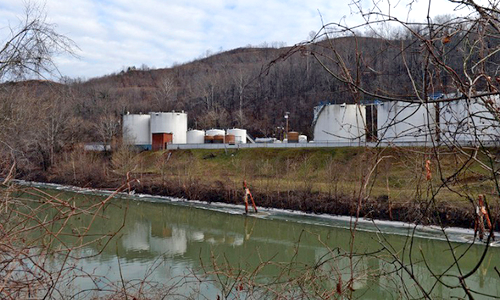

“Coal prep plant employees clearly are not drinking the frothing agent. These are two very different standards. It is inaccurate to mix the two,” Gravatt wrote.
Yet workers like Price claim they did inhale and ingest the chemicals they used in the frothing process.
“We ingested it, inhaled it, got it on our skin, even digested it,” Price said. “You’d be inside of a closed area and you’d stay wet with it, and we didn’t think much about it at the time until we started getting sick one by one.”
Today, Browning suffers from multiple chemical sensitivity and burning mouth syndrome. But relatively speaking, he’s doing better. For two months after his hospitalization, Browning said, his lungs burned. (He’s not a smoker.) It took almost two years for his bloodshot eyes to clear. In a stress test not long after the emergency, Browning said, “I couldn’t even stand up on a treadmill.”
Detoxification treatments (not covered by insurance) have cost Browning thousands of dollars, and his worker’s compensation claim was denied.
More Information for Better Solutions
Given how little we know about the toxicity and health impacts of chemicals, mapping out a clear alternative is difficult.
Dr. Alan M. Ducatman of the West Virginia University School of Public Health has been fielding health questions from prep plant workers for more than two decades. He said it’s hard to determine the cause of an ailment when you don’t know what chemicals workers are exposed to in the first place.
As a result, few symptoms explicitly point to prep plant chemicals as their cause, Ducatman explained—and there’s no single test that can determine whether these chemicals are at the root of workers’ health problems.
The solution, Ducatman believes, is more toxicity testing for the chemicals workers are using: “People talk about how much it costs [but] the industry is making a tremendous amount of money.”
Yet the challenge of this testing isn’t just financial—it’s also a problem of logistics.
“It’s a simple case that there are millions of chemicals available … It takes time to do these toxicity studies,” explained Dr. Timothy C. Eisele, assistant professor of chemical engineering at Michigan Tech. So the focus has been on chemicals that have already proven themselves dangerous.
But until these logistical problems have been solved, transparency and caution are essential, insisted Vernon Haltom, executive director of the nonprofit anti-mining organization Coal River Mountain Watch.
“We should be assuming it’s deadly toxic until shown otherwise, and even then not rely on one or two tests on rats 20 years ago,” Haltom said.
Dr. James G. Speight, who has worked as a chemist and consultant in the coal and oil industries for more than 45 years, agrees that caution is key.
In referencing one coal prep chemical, polyacrylamide, Speight said: “I tend to err on the side of caution and say that chemicals of that type are dangerous. They can be poisonous.”
Today, Browning has to be cautious about every chemical he uses, down to his detergent, but it’s not by choice. He’s highly sensitive to a lot of household chemicals, which can irritate his burning mouth and other symptoms.
“I was a five- and six-day worker every week. … I was an everyday man, and I worked hard,” Browning said. “If people knew what I went through—they don’t have enough money to compensate you for this stuff.”
The Dangers of Polyacrylamide
While it’s difficult to assess exactly how dangerous many prep plant chemicals are, that’s especially true of a substance called polyacrylamide. At first glance, polyacrylamide doesn’t look that bad. It’s even used in cosmetics and water treatment. But polyacrylamide poses two greater dangers: first, commercial polyacrylamide often contains traces of acrylamide, the essential building block for polyacrylamide. And second, polyacrylamide also tends to break down into acrylamide.
What’s wrong with acrylamide? It may cause cancer and birth defects. One potential health impact, neurotoxicity, was first observed in laboratory animals more than 56 years ago.
A report prepared for the California Public Health Foundation in 1988 confirmed that traces of the more dangerous acrylamide are “usually present in the various bulk commercial formulations” of polyacrylamide. A representative of the American Cyanamid Company (of which Cytec is a spinoff) is on the distribution list of this report—meaning that by the time the company produced the MSDSs, all dated after 1989, it should have known that there was some acrylamide in its polyacrylamide products.

 233k
233k  41k
41k  Subscribe
Subscribe 